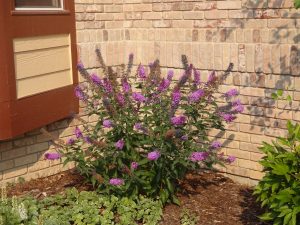If you’ve never done a rejuvenation pruning, you are sure to think it is harsh or a good way to kill a shrub. Actually, some shrubs respond to this type of pruning very well and produce even more flowers when cut back regularly. “Rejuvenation pruning” really means cutting the plant down to its base. It should be done in early spring but should not be done every single year. Not all plants appreciate rejuvenation pruning, but some that respond well are Butterfly Bush, Blue Mist Spirea, Dogwood, Spirea, Forsythia, and Rose of Sharon.



The next picture was taken in August of 2017. You can see that the bush is blooming happily although it is much shorter and less wide than the year before. In 2018 it was about twice this size and again bloomed happily. Since I want to keep it snugly in this corner, rejuvenation pruning every few years controls the size of the shrub. If this shrub was really out-growing its space, it could be cut back every year but for my purposes, every 3 years is plenty. It’s March of 2019 as I write this, so I can procrastinate cutting back the Butterfly Bush for another year!

One year I got a little excessive when cutting back my Blue Mist Spirea (Caryopteris x clandonensis) and cut it all the way to ground level. It got a slow start in the spring, but came back strong and by July looked the same as any other year. So, don’t be worried about cutting the plant too harshly so long as the shrub has been growing well for a few years.

